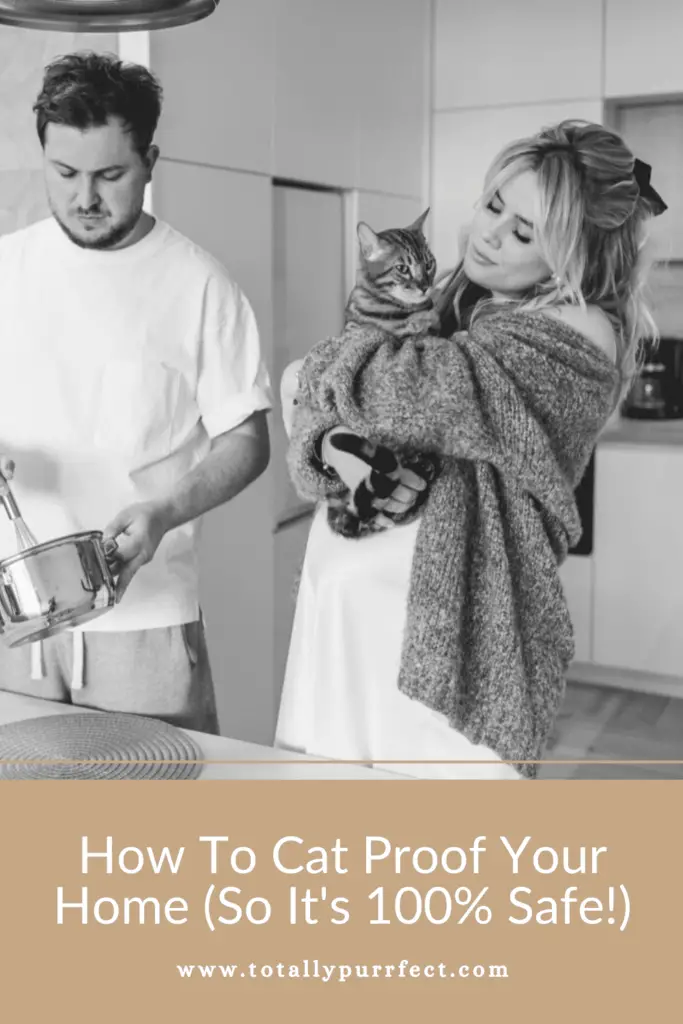Want to keep your cat safe, and your home as in-tact was you possibly can? Then cat proofing your home is the answer! But what do you do? How do you cat proof your home? In this post, we’ll run through it all – with your simple, easy-to-follow “tick-list” for how to cat proof your home. So let’s get stuck straight in, shall we?
How To Cat Proof Your Home
When it comes to cat proofing your home – it’s simpler than you think. Ask yourself:
- What could be a potential hazard here; what might be dangerous?
- What could my cat do here; what should I think about?
- And how do cats typically behave? What might they do? What could the impact of this be? Andow can I better protect my house or furniture here? (This is especially relevant if you’re looking for how to cat proof your home as you have a new cat or kitten moving in, and you don’t 100% know how they’ll behave yet!)
To make it nice and easy for you, we’ve created a tick-list of the key things to do or think about if you want to cat proof your home. So, in no particular order…
Your Guide To Cat Proofing Your Home
Let’s get going, shall we? To cat proof your home, you want to:
1) Wrap Up Any Cords / Cables
Hanging cords, cables or tangles of wires are NOT toys for your cat. However, with them not knowing this, it can become very dangerous. (Especially if they’re plugged in and electricity is flowing through.)
For this reason, you want to:
- Switch off and unplug any cables you’re not using and put them away in a safe place wherever you can.
- Box up any wires / cables if at all possible. (This is what we did in our cat room before beginning the work on there. We boxed them up and created secret cupboards / units to hide them! It made it far safer!)
- You also want to tie up any cords – especially ones from curtains or blinds. We actually clip ours up with one of these so that they don’t dangle down and can’t be played with. Similarly, these blind tie hooks will do the trick if the material is string. So it’s only something small you need – but it makes a major difference!
2) Keep Chemicals / Medications Away
Having a cat about the house is, in some ways, similar to having a baby around – especially if your cat is a kitten or especially curious! So one thing to remember when it comes to cat proofing your home, is to never, ever, leave chemicals lying around! Even with the lids on…
Some household cleaning products, when ingested by a cat, can cause profuse drooling, chemical burns, vomiting, and difficulty breathing.
And sure, they can’t open them by themselves but if they leak or get knocked over, the effects can be severely catastrophic.
For instance, mothballs and fabric softener sheets can be toxic. Cleaning products can cause chemical burns, vomiting and difficulty breathing. Even cigarettes and batteries can also cause your cat problems. Not to mention medications!
A major one to be aware of, are antidepressants, because these things are like catnip to cats!
The problem is, instead of improving their mood and energy level, antidepressants can cause lethargy, tremors, seizures, vomiting, diarrhea, and hyperthermia in cats.
So a major “must-do” when cat proofing your home, is to check for anything that could potentially cause harm and keep it carefully out of reach for your cat.

3) Be Aware of Poisonous Foods
There’s also poisonous foods for cats, that you need to be aware of.
Things like onions & garlic; grapes & raisins; chocolate and even raw eggs, raw meat & bones (to mention just a few), can all cause pretty serious issues for your cat. So swat up on what’s okay and what’s not.
Here, we’ve created a little guide for you with the: (Surprising!) Foods Cats Can’t Eat.
Because, yes, most of these things cause the most damage in large doses, but it’s important to be aware of, and make sure they avoid any sort of consumption at all.
So consider this BEFORE your cat arrives and make sure everything is properly stored away in cupboards. Whilst we’re on the topic of food…
4) Cover Your Trash Cans
Most cats love to explore… But exploring in trash cans leaves them not only digging out unsavoury items that may make them sick, but also making a mess in the process! (Not what you want if you’re looking to cat proof your home!)
They can also cut themselves on items inside the bin, or from the bin itself. So try to prepare by getting a bin with a lid and switch from a mental to a plastic trash can. (Job done!)
5) Check For Poisonous Plants
I know, I know, you thought we were done with poisonous substances, but LISTEN UP, as this is a big one!
See, some of the most common household and garden plants are incredibly dangerous. Just one bite of things like…
- tulips
- daffodils
- lilies
- philodrendon
- dieffenbachia
- foxglove
- and Japanese yew
… can actually kill your cat. (Horrible to think of, I know.) Even licking the pollen or lapping up water from the vase can result in severe, potentially irreversible acute kidney failure.
If this isn’t proof you must cat proof your home – I don’t know what is. Reality check, or what?
Also be aware that if you’re having an indoor-outdoor cat, this doesn’t just stop at indoors. There are outdoor plants poisonous to cats too. And even homegrown veggies that can cause a lot of damage!
So whether you’re using a square foot garden planner or sprucing up your entire plot – just check first that your outdoor garden is just as safe as indoors for your little furry friend!

Cat Proofing Your Home
What else do you need to do, or know, when it comes to creating a safe environment for your new furry friend? Well…
6) Cover Your Carpet / Furniture
We’ve spoken previously about why cats scratch – and how to stop them from scratching your carpet or furniture. (So the good news is – it doesn’t necessarily have to happen or last!
But cats are wired to scratch, so as a precautionary measure – before discovering their habits – it’s a good idea to cover your furniture (with throws etc) to provide a protective layer.
If you have cheaper curtain alternatives or an OLD quilt cover, vs a brand new one (for example), these things you’ll be thankful for, during training.
Likewise, if you’re getting a kitten and it’s not yet litter trained, you may like to cover it with a see-through floor protector. (It works an absolute treat, and keeps your carpet clean, until your kitten learns how to!)
7) Look Out For “Risky Objects”
Next up, if you want to cat proof your home, you have to go into inspector mode!
- Are there any fragile objects that could easily get knocked off and broken?
- How about sharp edges? Are there any of those that need to be softened or covered?
- And what about any small items that you wouldn’t leave lying around a baby? Because the same should apply when cat proofing your home. If they’re not safe around a baby, they won’t be safe around a cat either – especially a kitten. (They will end up nibbling on ANYTHING!)
So, walk around your home. Look at EVERYTHING! Hide what you need to, or replace it to a safer place.
Not only does it protect your things, keeping them in tact, but also keeps your cat safe as broken objects will hurt if your cat steps on them or eats them. (Ouch.)
8) Watch For Windows
If your home is your apartment and you’re therefore looking to cat proof your apartment, one of the most fundamental things you must, must, must do, is think about your windows.
- Do you live in a multi-story apartment block?
- Is there a big drop from the windows, that would have serious consequences if your cat was to get out, and drop?
- Or maybe your house is a house cat for now, and it’s not safe for them to go out for another reason?
Whatever it is, if your windows need to be secure – they need to be secure! So:
- Check they won’t push open when they’re closed. They latch works properly and effectively.
- Think about how you can safely open them, without your cat being able to get out.
For our windows, we’ve bought these magnetic window screens, and – as we have a Maine Coon kitten who is going to grow rather big and strong indeed, we’ve also grabbed some extra duct tape to secure it further.
This way, we still get fresh air in, without him getting out. (Totally purrfect!)

9) Make Sure You’re Fully Prepared
One of the best pieces of advice, when making your home cat proof, is to make sure you’re fully prepared.
This means having everything that your new cat / kitten needs, when or before it needs it. So we’re talking:
- Plenty of different scratching posts (to again, stop the scratching and destruction.)
- Lots of cat toys (to keep them entertained) – both toys cats can play with by themselves (when you’re busy, but want to keep them occupied!) but also ones you can play with them. After all, there’s plenty of different games you can play with your cat, but you may need to get a few things in, in order to do this. This leads me onto my final point…
- The biggest thing you can and should, of course, give – is your time.
The more you can be around your cat / kitten (especially in the early days as they start to build a bond with you and get settled in), the happier and better looked after they will be and the less damage they will naturally do!
Plus, the more you put into being a Cat Mom / Dad, the more you will inevitably get out of it. So don’t do things by halves!
10) Keep Your Home Safe When Your Cat Is There…
Remember – cat proofing your home before you cat arrives, is only the first part. (There’s a lot involved when it comes to preparing for a cat or kitten!)
Once they are then there, you have to not only keep on top of all the things mentioned above, but also become even more aware of things like:
- Making sure they’re not in the washing machine, tumble drier or dishwasher before you put it on.
- Not leaving candles unattended, as their fluffy little tails sure are easy to get caught alight!
- Remembering to put the toilet seat down so that older cats can’t drink from it and younger cats / kittens can’t fall into it. (Yikes. Write a note on the toilet seat to get you into the habit of remembering if you need to!)
- And checking rooms before you leave the house so that you don’t accidentally lock your cat in one. Etc.
It sounds like a lot to remember, but it’s just about becoming more aware as you embrace your new life living with your lovely furry friend.
That’s All For This One
So there we have it – your master guide for how to cat proof your home. Hope this helps!
Thanks for reading. Be sure to browse our articles for more!
What things do you do to cat proof your home? We’d love to hear. Comment in the box below.

